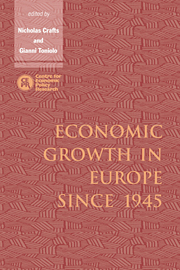Book contents
- Frontmatter
- Contents
- List of figures
- List of tables
- Preface
- List of contributors
- 1 Postwar growth: an overview
- 2 Institutions and economic growth: Europe after World War II
- 3 The varieties of Eurosclerosis: the rise and decline of nations since 1982
- 4 Why the 1950s and not the 1920s? Olsonian and non-Olsonian interpretations of two decades of German economic history
- 5 Convergence, competitiveness and the exchange rate
- 6 British economic growth since 1945: relative economic decline … and renaissance?
- 7 Economic growth in postwar Belgium
- 8 France, 1945–92
- 9 Economic growth and the Swedish model
- 10 Characteristics of economic growth in the Netherlands during the postwar period
- 11 Portuguese postwar growth: a global approach
- 12 Growth and macroeconomic performance in Spain, 1939–93
- 13 Irish economic growth, 1945–88
- 14 Italy
- 15 West German growth and institutions, 1945–90
- 16 An exercise in futility: East German economic growth and decline, 1945–89
- 17 Postwar growth of the Danish economy
- 18 Reflections on the country studies
- Index
7 - Economic growth in postwar Belgium
Published online by Cambridge University Press: 04 August 2010
- Frontmatter
- Contents
- List of figures
- List of tables
- Preface
- List of contributors
- 1 Postwar growth: an overview
- 2 Institutions and economic growth: Europe after World War II
- 3 The varieties of Eurosclerosis: the rise and decline of nations since 1982
- 4 Why the 1950s and not the 1920s? Olsonian and non-Olsonian interpretations of two decades of German economic history
- 5 Convergence, competitiveness and the exchange rate
- 6 British economic growth since 1945: relative economic decline … and renaissance?
- 7 Economic growth in postwar Belgium
- 8 France, 1945–92
- 9 Economic growth and the Swedish model
- 10 Characteristics of economic growth in the Netherlands during the postwar period
- 11 Portuguese postwar growth: a global approach
- 12 Growth and macroeconomic performance in Spain, 1939–93
- 13 Irish economic growth, 1945–88
- 14 Italy
- 15 West German growth and institutions, 1945–90
- 16 An exercise in futility: East German economic growth and decline, 1945–89
- 17 Postwar growth of the Danish economy
- 18 Reflections on the country studies
- Index
Summary
Introduction
Over the postwar period as a whole, the Belgian economy has grown more or less in line with the economies of its neighbours. Long an industrialized country, Belgium was relatively well-off after the Second World War and remains so today. But Belgian postwar growth followed a distinctive path, the main feature of which was a sharp improvement in its relative performance around 1960. Belgium started the postwar period with an economic structure that resembled that of the UK, another early industriahzer, and, like the UK, it lagged behind other countries in improving productivity during the 1950s. Since 1960 Belgian growth has accelerated, and productivity growth, especially in manufacturing industry, has been unusually rapid and sustained. One major task of this chapter is to explain why growth was relatively weak before the 1960s and why it improved so strikingly thereafter. Another is to consider the nature and sustainability of Belgium's relatively strong growth performance in the 1970s and 1980s, particularly when seen against its very high unemployment rate and the parlous state of its public finances.
This survey builds on a diverse, yet relatively underdeveloped, secondary literature. There have only been a few attempts to survey the Belgian experience of economic growth since the war (De Brabander, 1981; Van Rijckeghem, 1982; Vandewalle, 1982; Vandeputte, 1985, 1993; Van der Wee, 1985, 1987; Mommen, 1994). The rest of the existing literature tends to break at around 1960, although not because relative performance improved then.
- Type
- Chapter
- Information
- Economic Growth in Europe since 1945 , pp. 173 - 209Publisher: Cambridge University PressPrint publication year: 1996
- 6
- Cited by



